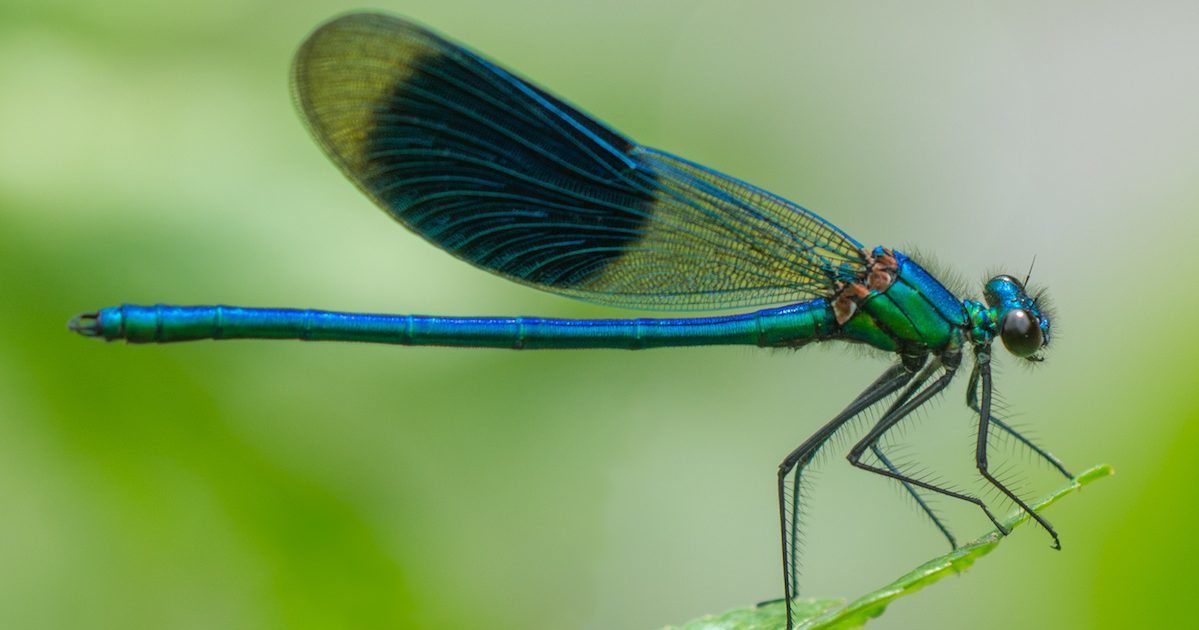
There is a huge group of people that are fascinated with dragonflies. Want to know more about these interested insects? Here is more information about them.
Dragonflies
“A dragonfly is an insect belonging to the order Odonata, infraorder Anisoptera. Adult dragonflies are characterized by large, multifaceted eyes, two pairs of strong, transparent wings, sometimes with colored patches, and an elongated body. Dragonflies can be mistaken for the related group, damselflies (Zygoptera), which are similar in structure, though usually lighter in build; however, the wings of most dragonflies are held flat and away from the body, while damselflies hold the wings folded at rest, along or above the abdomen. Dragonflies are agile fliers, while damselflies have a weaker, fluttery flight. Many dragonflies have brilliant iridescent or metallic colors produced by structural coloration, making them conspicuous in flight. An adult dragonfly’s compound eyes have nearly 24,000 ommatidia each.
Fossils of very large dragonfly ancestors in the Protodonata are found from 325 million years ago (Mya) in Upper Carboniferous rocks; these had wingspans up to about 750 mm (30 in). There are about 3,000 extant species. Most are tropical, with fewer species in temperate regions,” reports Wikipedia.org.
Fastest flying insect
According to Smithsonian, “the fastest flying Insect is the Dragonfly which are known to travel at the speed of 35 miles an hour. Hawk Moths, which have been clocked at a speed of 33.7 miles an hour, come in second. Dragonflies can travel at 100 body-lengths per second in forward flight, and three lengths per second backwards. The dragonfly is the longest distance traveler / flyer in the world. The longest distance that this species can fly is up to 11,000 miles (almost 18,000 kilometers)”. Dragonflies are hunters and they prey on other flying insects. They use their speed and agility to help them catch their meal in midair.
Flight
Dragonflies are powerful and agile fliers, capable of migrating across the sea, moving in any direction, and changing direction suddenly. In flight, the adult dragonfly can propel itself in six directions: upward, downward, forward, backward, to left and to right.
They have four different styles of flight:
- A number of flying modes are used that include counter-stroking, with forewings beating 180° out of phase with the hindwings, is used for hovering and slow flight. This style is efficient and generates a large amount of lift;
- Phased-stroking, with the hindwings beating 90° ahead of the forewings, is used for fast flight. This style creates more thrust, but less lift than counter-stroking;
- Synchronized-stroking, with forewings and hindwings beating together, is used when changing direction rapidly, as it maximizes thrust; and
- Gliding, with the wings held out, is used in three situations: free gliding, for a few seconds in between bursts of powered flight; gliding in the updraft at the crest of a hill, effectively hovering by falling at the same speed as the updraft; and in certain dragonflies such as darters, when “in cop” with a male, the female sometimes simply glides while the male pulls the pair along by beating his wings.
The wings are powered directly, unlike most families of insects, with the flight muscles attached to the wing bases. Dragonflies have a high power/weight ratio, and have been documented accelerating at 4 G linearly and 9 G in sharp turns while pursuing prey.
Meaning
“The dragonfly, in almost every part of the world symbolizes change and change in the perspective of self-realization; and the kind of change that has its source in mental and emotional maturity and the understanding of the deeper meaning of life,” reports Dragonfly-site.com.
Harmful?
Dragonflies are not usually harmful to humans. Sometimes large dragonflies will try to bite, but they fail to break the skin. They can be a wonderful asset during the spring and summer months when mosquitoes are most active because a single dragonfly can consume hundreds of mosquitoes a day.
If you have an insect problem, contact a local experienced pest control company?
Drive-Bye Exterminators offers home and commercial pest control services in Clearwater, Florida, and the surrounding areas. Family owned and operated for over 25 years, Drive-Bye Exterminators has state certified inspectors and exterminators provide roach, subterranean termite, dry wood termite, roaches, spider, ant and flea services to both commercial and residential clients. Whether a business owner needs help getting rid of a termite infestation, or a homeowner wants to rid their kitchen of ants, Drive-Bye Exterminators offers each client the same level of professionalism and excellence.
Request a FREE Pest Control or Termite Inspection today with the Professionals of Drive-Bye Exterminators. Contact Us Today at 727-787-2127.






